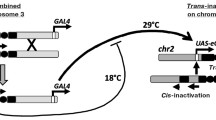Abstract
We studied a set of Drosophila melanogaster strains that could be potentially suitable for testing a variety of mutagenic factors. Their genomes contained insertions of the enhancer trap P {lacW}-in which the activity of the LacZ reporter is under the control of the reparation genes’ regulatory region. We demonstrated that the beta-galactosidase reporter, which is encoded by insertion of P {lacW} element in the gene mus209, is induced by irradiation in the cells of the salivary glands and wing imaginal discs. Despite the fact that the reporting coloration is not associated with the dose of radiation treatment, we found that the induction threshold of the reporter is different for these tissues. Thus, coloration in salivary glands is detectable after the dose of 200 rad and above, whereas the imaginal discs get colored with 500 rads and above. Thereby, multiple thresholds for induction of the reporter in the various tissues allow approximating the received dose.
Similar content being viewed by others
References
Ames, B.N., Durston, W.E., Yamasaki, E., and Lee, F.D., Carcinogens are Mutagens: a simple test system combining liver homogenates for activation and bacteria for detection, Proc. Nat. Acad. Sci. U. S. A., 1973, vol. 70, no. 8, pp. 2281–2285.
Mitchell, A.D., Myhr, B.C., Rudd, C.J., Caspary, W.J., and Rudd, C.J., Evaluation of the L5178Y mouse lymphoma cell mutagenesis assay: methods used and chemicals evaluated, Environ. Mol. Mutagen., 1988, vol. 12 (suppl. 13), pp. 1–18.
Galloway, S.M., Armstrong, M.J., Reuben, C., Colman S., Brown, B., Cannon, C., Bloom, A.D., Nakamura, F., Ahmed, M., Duk, S., et al., Chromosome aberrations and sister chromatic exchanges in Chinese hamster ovary cells: Evaluations of 108 chemicals, Environ. Mol. Mutagen., 1987, vol. 10 (suppl. 10), pp. 1–175.
Witt, K.L., Livanos, E., Kissling, G.E., Torous, D.K., Caspary, W., Tice, R.R., and Recio, L., Comparison of flow cytometry- and microscopy-based methods for measuring micronucleated reticulocyte frequencies in rodents treated with nongenotoxic and genotoxic chemicals, Mutat. Res., 2008, vol. 649, nos. 1/2, pp. 101–113.
Margolin, B.H., Resnick, M.A., Rimpo, J.Y., Archer, P., Galloway, S.M., Bloom, A.D., and Zeiger, E., Statistical analyses for in vitro cytogenetic assays using Chinese hamster ovary cells, Environ. Mutagen., 1986, vol. 8, no. 2, pp. 183–204.
Zimmering, S., Mason, J.M., Valencia, R., and Woodruff, R.C., Chemical mutagenesis testing in Drosophila. 2. Results of 20 coded compounds tested for the National Toxicology Program, Environ. Mol. Mutagen., 1985, vol. 7, no. 1, pp. 87–100.
Zimmering, S., Mason, J.M., and Valencia, R., Chemical mutagenesis testing in Drosophila. 7. Results of 22 coded compounds tested in larval feeding experiments, Environ. Mol. Mutagen., 1989, vol. 14, no. 4, pp. 245–251.
Erciyas, A.F., Erciyas, K., and Sarikaya, R., Genotoxocity of two mouthwash products in Drosophila Wing-Spot Test, Food Chem. Toxicol., 2010, vol. 48, no. 10, pp. 2577–2580.
Zhitelzon, I.I., Ecological Biophysics: Ecosystem Photobiologics, Moscow: Logos, 2002, pt. 1.
Hastwell, P.W., Chai, L.-L., Roberts, K.J., Webster, T.W., Harvey, J.S., Rees, R.W., and Walmsley, R.M., Highspecificity and high-sensitivity genotoxicity assessment in a human cell line: validation of the GreeScreen HC GADD45a-GFP genotoxicity assay, Mutat. Res., 2006, vol. 607, no. 2, pp. 160–175.
Mishra, M., Sharma, A., Shukla, A.K., Kumar, R., Dwivedi, U.N., and Kar Chowdhuri, D., Genotoxicity of dichlorvos in strains of Drosophila melanogaster defective in DNA repair, Mutat. Res., 2014, vol. 766, pp. 35–41.
Moldovan, G.-L., Pfander, B., and Jentsch, S., PCNA, the maestro of the replication fork, Cell, 2007, vol. 129, no. 4, pp. 665–697.
Szkanderova, S., Port, M., Stulik, J., Hernychova, L., Kasalova, I., van Beuningen, D., and Abend, M. Comparison of the abundance of 10 radiation-induced proteins with their differential gene expression in L929 cells, Int. J. Radiat. Biol., 2003, vol. 79, no. 8, pp. 623–633.
Author information
Authors and Affiliations
Corresponding author
Additional information
The article is published in the original.
About this article
Cite this article
Yasinskiy, Y., Omelyanchuk, L.V., Zhuk, O.V. et al. Mutagenesis testing using the LacZ reporter activity of the reparation gene mus209 in Drosophila melanogaster . Cytol. Genet. 50, 158–161 (2016). https://doi.org/10.3103/S0095452716030105
Received:
Published:
Issue Date:
DOI: https://doi.org/10.3103/S0095452716030105



